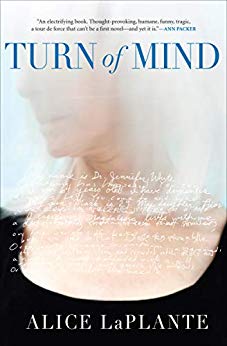Alice LaPlante
New York
Atlantic Monthly Press
2009
307 pages
According to the Art:
This murder mystery features a prime suspect with Alzheimer’s disease and who serves as the narrator. The suspect’s disease is advanced enough to make her an unreliable narrator and witness. Because of the author’s personal interest in dementia, the novel offers ideas on how people experience it amid complex circumstances. The author also imagines an end stage of dementia that could be more pleasant than common perceptions may have it.
Synopsis:
This novel is a murder mystery, narrated by the prime suspect, who is an unreliable narrator because she has Alzheimer’s disease.
Dr. Jennifer White is a sixty-four-year old, retired, orthopedic surgeon who specialized in hand surgery. She has been a widow for many years, and has two adult-aged children, a son and a daughter. She has someone in her house to help her, Magdalena. Jennifer has lived in Chicago for over thirty years, and most of it three houses down from Amanda, who is her best friend and her daughter’s godmother. Amanda has been murdered in her home. Jennifer is a suspect, in large measure because Amanda’s body was found with four fingers of one hand surgically removed.
Jennifer’s dementia is advanced enough at the time the story begins that she cannot be sure of much recent history or of whom she is talking to at any given moment. A lot of her narration, along with elaborations and corrections, comes mostly through a “notebook” that contains entries she and others contribute.
The notebook is a way of communicating with myself, and with others. Of filling in the blank periods. When all is in a fog, when someone refers to an event or conversation that I can’t recall, I leaf through the pages. Sometimes it comforts me to read what’s there. Sometimes not. It is my Bible of consciousness.
p. 5
The plot takes into account the vicissitudes of Jennifer’s relationship with Amanda, her husband’s depredations, her children’s alternating comfort and conniving, and law enforcement reactions to a suspect’s worsening dementia. Jennifer, herself, is never much help during the investigations because of her memory, cognition, and language problems, though at times: “Something nags. Something that resides in a sterile, brightly lit place where there is no room for shadows. The place for blood and bone. Yet shadows exist. And secrets.” (p. 153) The mystery is solved in the end.
The author, Alice LaPlante, shifts Jennifer’s narration to second-person and then eventually to third-person as her dementia worsens through the course of the story. In a personal communication with me, LaPlante said the “move from first, to second, to third person was my attempt to render Jennifer’s increasing distance from the world, and from her ‘self’ that had existed in that world.”
Analysis:
The book can be of interest to readers of complicated mysteries or readers interested in literary renderings of dementia experiences amid complicated circumstances.
While LaPlante uses dementia as a context for her mystery plot, she goes further to imagine what dementia can be like to those who suffer it, and at different stages as well. In a 2011 interview in The Guardian, she said she had been inspired to write about her mother’s dementia. “I wanted to put myself in that position, to understand what my mother’s going through, and I just imagined myself into it.” She tried other literary forms before she tried a murder mystery. Her book, therefore, offers more than the thrill of a good mystery, but also thoughts on how dementia might be experienced.
The existence of a notebook that Jennifer writes in and reads from allows that she has some awareness of her predicament, and her slide into it.
It started a while ago. Months. I noticed I was forgetting things. Little things, like where I’d put my keys or my wallet or the box of past I’d taken out of the pantry. Then these gaps. One minute I’d be in my office, the next in the Jewel frozen foods section with no recollection of how I’d got there. Then words starting to go. I was in the middle of surgery and I had to say, Give me that shiny thing that pinches and holds. I saw my residents exchanging glances. Humiliating.
p. 135
LaPlante further imagines that some people with the disease can hang on to their awareness of technical explanations for their problems as well, at least for awhile.
That half state. Life in the shadows. As the neurofibrillary tangles proliferate, as the neuritic plaques harden, as synapses cease to fire and my mind rots out, I remain aware. An unanesthetized patient. (p. 8)
What is there to understand? I have a degenerative disease. There is no cure for that disease. That is the condition facing hundreds of thousands of people around the world. (p. 99)
Some aspects of the dementia experience LaPlante describes for Jennifer are similar to other literary descriptions, in particular those involving the occurrence of random thoughts and memories (see Samantha Harvey’s The Wilderness and Walter Mosley’s The Last Days of Ptolemy Grey).
Small moments. My cat, Binky, up a tree when I was five. A pair of my underwear blowing off the clothesline in the wind and into Billy Plenner’s yard next door when I was in seventh grade—something that he never let me forget. Finding a five-dollar bill on the floor of the roller–skating rink and feeling rich. (p. 128)
p. 128
But, she goes deeper into Jennifer’s experience than these kinds of literary descriptions when she adds some pathos. In answering her daughter’s question about how she experiences it, for example, Jennifer says,
As termites eating away at my emotions. Nibbling at the edges at first, then going deeper until they destroy. Robbing me of my chance to say good-bye. You think, Tomorrow, or next week. You think you still have time…But all the while the termites are doing their work, and before you know it, it’s no longer possible to feel the loss honestly or spontaneously.
p. 175
LaPlante also imagines what the experience might be at the very end of life for someone with dementia, and one that is more than just the frass termites left when they had eaten all the way through Jennifer’s soul. At this point Jennifer is institutionalized and does not communicate in any form, and so her third-person narration is left to voice what her experience might be when, “now that it’s over, now that it’s near the end, she can think. She can allow herself to drift to places that before she would not go.” (p. 297)
It’s the visions that make the waiting possible. And what visions! In glorious color, all senses activated. Fields of blooming, perfumed flowers, gleaming sterile operating rooms ready for cutting, beloved faces that she can reach out and caress, and soft hands that caress back. Heavenly music. p. 297
p. 297
Is this right? After a long march through the hell of dementia, are such visions, caresses, and heavenly music available at the very end? It’s a nice thought, a salvaging thought, and a thought that reinforces what literature and the arts more generally do to expand the possibilities we can consider when faced with illness and other challenges common to the human journey.
Also:
This novel is the first work of fiction to be awarded the Wellcome Trust book prize (2011). The judges said the book “emphatically confirms the ability of literature to tell us more about the heart and soul of an illness than any textbook.”
Plans to make a movie of this novel were announced in May of 2019.
A comparison of the literary renderings of dementia in this novel are compared to classic biomedical text here.



